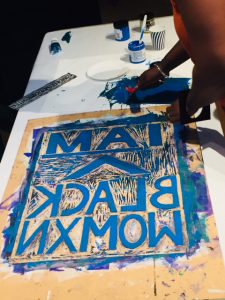Investing in the Creative Economy

“I AM A BLACK WOMXN.” by Ashara Ekundayo, CEO & curator, AECreative and Ashara Ekundayo Gallery
I got up at 6:00 AM on the final day of the conference to attend a 7:30 AM session (ouch!) on Impact Investing in the Creative Economy. For most of us in the room, impacting investing was a newer concept. We were eager to learn about the diversity of resources available to build and sustain art-making endeavors through both philanthropic and investment opportunities.
I’d spent the previous day in a session at the Betti Ono Gallery organized by Alexa Hall (program fellow, Performing Arts, William and Flora Hewlett Foundation) focused on Oakland Arts Collectives: Resource sharing and innovation. The panel included creative entrepreneurs who run incubators for artists and the community in Oakland. These business owners/executive directors spoke of Oakland as a hub for homegrown locals, and a space that welcomes newcomers, artists that have been displaced from other cities. From creating co-working spaces at that center creativity and technology to running and arts center featuring artist work and community programs, one panelist commented, “I am an artist whose practice is curation. A reminder to be unapologetically Black with joy,” and, “Oakland’s arts ecology is spiritual. It’s an undertone that we don’t always speak to” but is a central element to how they show up and engage. They do this as non-profit organizations, and as hybrid model LLC and Certified B Corporations.
Panelists shared that such hybrid models can provide the ability to be nimble – allowing for revenue generation, and, in the case of having a non-profit wing, opportunities for resources that support education and community programming, offering a clear need for maintaining philanthropic partnerships.
For example, Betti Ono Gallery (BOG) presents artist work and provides a creative and safe space for community. They’ve led youth-centered engagement projects dealing with structural violence, facilitated by organizers and teaching artists to address trauma and build collective power focused on community narratives. BOG does the work of cultural organizing by “embedding artists in movement building efforts through rapid response efforts that address acute issues and inform ongoing opportunity in cultural space.” This has led to The Fire Next Time: A Call & Response, a year-long arts, culture, and community engagement initiative launching on that is “part cultural think tank + exhibition + instigation.”
But, there are also challenges with making enough money to do more than pay the lease and keep the lights on.
Impact Hub Oakland (IHO) co-working space is an arts incubator. To get started, they raised close to $150K from over 1100 donors internationally. The majority of donors were Oakland residents – a testament to both local community support, and the need for accessible cultural spaces like IHO that offer innovative opportunities within the city. While support is strong, and affordable rental fees cover the bills, no equity is being built.
It behooves the sector to take a closer look at the work being implemented in these spaces, and respond in kind to the knowledge and expertise of creative and community-minded leaders and entrepreneurs like Anyka Barber (Founder/Owner, Betti Ono Gallery), Ashara Ekundayo (CEO & curator, AECreative and Ashara Ekundayo Gallery) and Anna Schniederman(executive director, The Flight Deck & Ragged Wing Ensemble) who offer the following:
- “Put the money directly in the hands of artists.”
- “To the philanthropic organizations funding this work: Do some internal work around racism, power, white privilege so that you can see the barriers you erect and maintain that keep artists out through application practices and selection committees.”
- “Read up on the history of the Non-profit industrial complex.”
- “Consider cultural rapid response funds and initiatives – understand what movement building looks like and embed that into what you fund. We need this type of funding to take more risks so that we can be more responsive, test out ideas, and have more permission for those ideas to be generative in shapes that we might not expect.”
- “Be aware of who you are not funding, beyond who is in your portfolio. What are people doing who are not being funded by you – learn about them, and have that inform what you do, and don’t do.”
- “We need more cultural space initiatives, public infrastructure support. If artists and cultural producers can’t afford to be here/live here, then the art is not here, neither is the opportunity to leverage arts and culture to engage and support community.”
So, where can funders and artists alike learn more about impact investing and the creative economy? Laura Callanan, founding partner of Upstart Co-Lab describes how investors are “unleashing more capital to entrepreneurs to scale and maintain their ideas.”
There’s a staggering $8.7 trillion dollars in socially responsible impact investing compared to $435 billion in philanthropic investing, 5% of which goes to the arts. How can the creative sector partner with and tap into these resources in ways that center and drive social enterprise work in order to deepen impact that is sustainable and thrives?
Upstart’s newly released report, HIDING IN PLAIN SIGHT: Impact Investing in the Creative Economy, looks at more than 100 funds with $60 billion of aggregate assets that have been investing in the creative economy over the past 5 years. These include conventional, socially responsible, and impact funds focused on ethical fashion, sustainable food, social impact media, other creative businesses and creative places. Key learnings include how the creative economy offers impact value, commercial viability and innovative edge; how a creativity lens correlates with diversity, equity, inclusion; and how a creativity lens is relevant in both developed and developing markets.
Get to know the creative entrepreneurs leading the way, and the foundations and investors providing ethical opportunities in support of their work.
